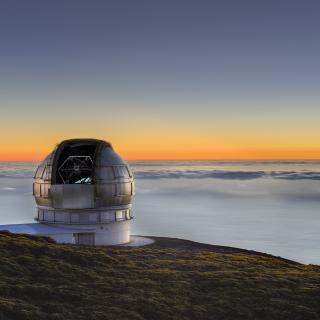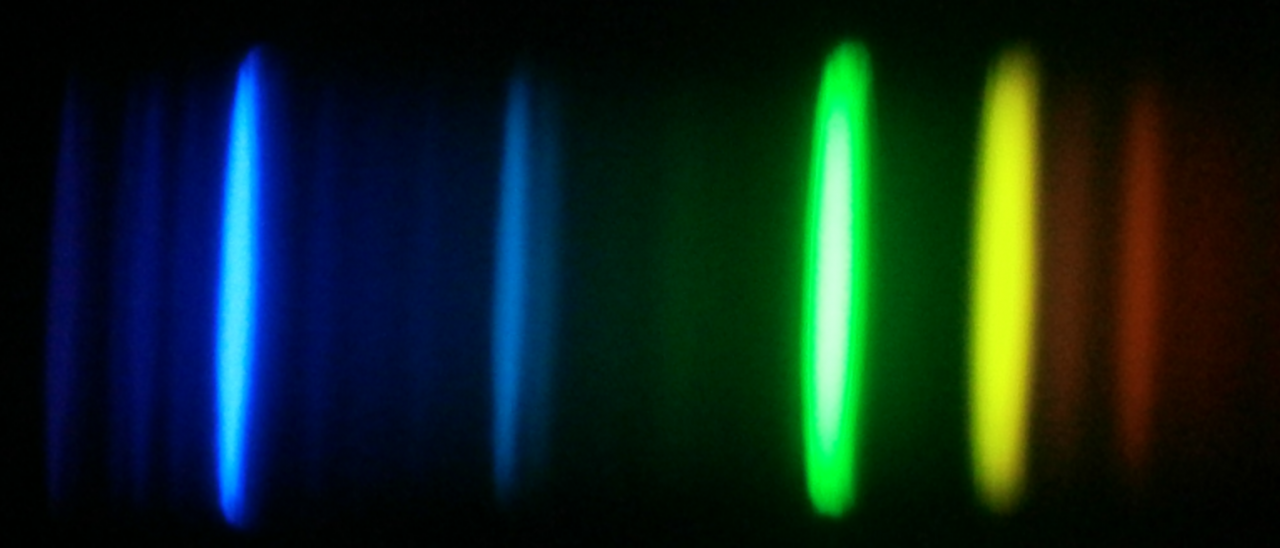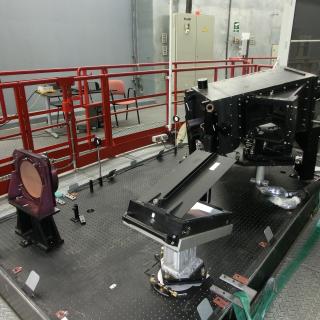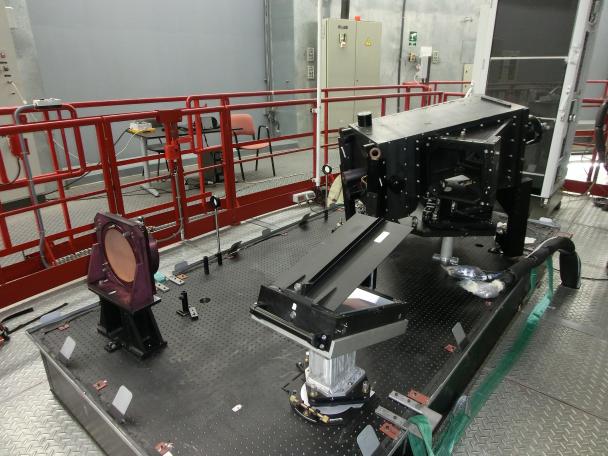Grants related:
General
Stellar spectroscopy allows us to determine the properties and chemical compositions of stars. From this information for stars of different ages in the Milky Way, it is possible to reconstruct the chemical evolution of the Galaxy, as well as the origin of the elements heavier than boron, created mainly in stellar interiors. It is also possible to study stellar formation, and the formation of the Galaxy, from the signature of the Galactic potential on the stellar orbits, and the distributions of mass, ages, and the abundance of heavy elements.
Obtaining high-resolution spectra, as necessary for studies of chemical compositions, requires advanced and efficient instrumentation. This is particularly true for research that calls for large stellar samples, which demands the observation of hundreds or thousands of sources simultaneously. Efficiency requires that the data processing and analysis are performed in an automated way.
The interpretation of spectra is based on physical models of the atmospheres of the stars, from where the light that we observe escapes the stars. The main ingredients for building such models are the fluid dynamics, and the properties of the atoms, ions, and molecules, especially regarding their interactions with the radiation coming from the stellar interior.
Once we have a plausible model, it is possible to compute in detail how the radiation propagates through the stellar atmosphere, and the emergent spectrum, which can then be iteratively compared with the observations to refine the model.
This project covers three different research fronts:
- Improving model atmospheres and simulations of stellar spectra.
- Developing tools for acquisition, reduction, and analysis of spectroscopic observations, in particular for the determination of chemical abundances in stars.
- Designing, preparing, and executing spectroscopic studies of stars aimed at understanding a) the most relevant aspects of the physics of stellar atmospheres, b) the formation and evolution of stars, c) the origin of the chemical elements, and d) the formation, structure, and evolution of the Milky Way galaxy.
Members
Results
- Complete the installation and commissioning of HORuS on GTC
- Discover two new stars with more than 100,000 times less iron than the Sun
- Complete the classification of all the APOGEE spectra with K-means
- Publish a complete collection of model stellar spectra for stars O to M
- Identify the signature of chemical diffusion in the atmospheres of the stars in the cluster M67
Scientific activity
Related publications
-
Back to the Lithium Plateau with the [Fe/H] < -6 Star J0023+0307
We present an analysis of the Ultraviolet and Visual Echelle Spectrograph (UVES) high-resolution spectroscopic observations at the 8.2 m Very Large Telescope of J0023+0307, a main-sequence extremely iron-poor dwarf star. We are unable to detect iron lines in the spectrum but derive [Fe/H] < -6.1 from the Ca II resonance lines assuming [Ca/Fe] ≥ 0
Aguado, D. S. et al.Advertised on:
42019 -
Exploring circumstellar effects on the lithium and calcium abundances in massive Galactic O-rich AGB stars
Context. We previously explored the circumstellar effects on Rb and Zr abundances in a sample (21) of massive Galactic O-rich asymptotic giant branch (AGB) stars. Here we are interested in clarifying the role of the extended atmosphere in the case of Li and Ca. Li is an important indicator of hot bottom burning while the total Ca abundances in
Pérez-Mesa, V. et al.Advertised on:
32019 -
Chemical Abundances of Main-sequence, Turnoff, Subgiant, and Red Giant Stars from APOGEE Spectra. II. Atomic Diffusion in M67 Stars
Chemical abundances for 15 elements (C, N, O, Na, Mg, Al, Si, K, Ca, Ti, V, Cr, Mn, Fe, and Ni) are presented for 83 stellar members of the 4 Gyr old solar-metallicity open cluster M67. The sample contains stars spanning a wide range of evolutionary phases, from G dwarfs to red clump stars. The abundances were derived from near-IR (λ1.5–1.7 μm)
Souto, D. et al.Advertised on:
32019 -
Chemical Cartography with APOGEE: Multi-element Abundance Ratios
We map the trends of elemental abundance ratios across the Galactic disk, spanning R=3{--}15 {kpc} and midplane distance | Z| =0{--}2 {kpc}, for 15 elements in a sample of 20,485 stars measured by the SDSS/APOGEE survey (O, Na, Mg, Al, Si, P, S, K, Ca, V, Cr, Mn, Fe, Co, Ni). Adopting Mg rather than Fe as our reference element, and separating stars
Weinberg, D. H. et al.Advertised on:
32019 -
Ca line formation in late-type stellar atmospheres. I. The model atom
Context. Departures from local thermodynamic equilibrium (LTE) distort the calcium abundance derived from stellar spectra in various ways, depending on the lines used and the stellar atmospheric parameters. The collection of atomic data adopted in non-LTE (NLTE) calculations must be sufficiently complete and accurate. Aims: We derive NLTE
Osorio, Y. et al.Advertised on:
32019 -
J-PLUS: The Javalambre Photometric Local Universe Survey
The Javalambre Photometric Local Universe Survey (J-PLUS ) is an ongoing 12-band photometric optical survey, observing thousands of square degrees of the Northern Hemisphere from the dedicated JAST/T80 telescope at the Observatorio Astrofísico de Javalambre (OAJ). The T80Cam is a camera with a field of view of 2 deg2 mounted on a telescope with a
Cenarro, A. J. et al.Advertised on:
22019 -
J-PLUS: Identification of low-metallicity stars with artificial neural networks using SPHINX
Context. We present a new methodology for the estimation of stellar atmospheric parameters from narrow- and intermediate-band photometry of the Javalambre Photometric Local Universe Survey (J-PLUS), and propose a method for target pre-selection of low-metallicity stars for follow-up spectroscopic studies. Photometric metallicity estimates for stars
Whitten, D. D. et al.Advertised on:
22019 -
Homogeneous analysis of globular clusters from the APOGEE survey with the BACCHUS code. I. The northern clusters
Aims: We seek to provide abundances of a large set of light and neutron-capture elements homogeneously analyzed that cover a wide range of metallicity to constrain globular cluster (GC) formation and evolution models. Methods: We analyzed a large sample of 885 GCs giants from the SDSS IV-Apache Point Observatory Galactic Evolution Experiment
Masseron, T. et al.Advertised on:
22019 -
Gaia Data Release 2. Properties and validation of the radial velocities
Context. For Gaia DR2, 280 million spectra collected by the Radial Velocity Spectrometer instrument on board Gaia were processed, and median radial velocities were derived for 9.8 million sources brighter than GRVS = 12 mag. Aims: This paper describes the validation and properties of the median radial velocities published in Gaia DR2. Methods
Katz, D. et al.Advertised on:
22019 -
Identifying Sagittarius Stream Stars by Their APOGEE Chemical Abundance Signatures
The SDSS-IV Apache Point Observatory Galactic Evolution Experiment (APOGEE) survey provides precise chemical abundances of 18 chemical elements for ∼176,000 red giant stars distributed over much of the Milky Way Galaxy (MW), and includes observations of the core of the Sagittarius dwarf spheroidal galaxy (Sgr). The APOGEE chemical abundance
Hasselquist, S. et al.Advertised on:
22019 -
Constraining Metallicity-dependent Mixing and Extra Mixing Using [C/N] in Alpha-rich Field Giants
Internal mixing on the giant branch is an important process which affects the evolution of stars and the chemical evolution of the galaxy. While several mechanisms have been proposed to explain this mixing, better empirical constraints are necessary. Here, we use [C/N] abundances in 26,097 evolved stars from the SDSS-IV/APOGEE-2 Data Release 14 to
Shetrone, M. et al.Advertised on:
22019 -
The Fifteenth Data Release of the Sloan Digital Sky Surveys: First Release of MaNGA-derived Quantities, Data Visualization Tools, and Stellar Library
Twenty years have passed since first light for the Sloan Digital Sky Survey (SDSS). Here, we release data taken by the fourth phase of SDSS (SDSS-IV) across its first three years of operation (2014 July–2017 July). This is the third data release for SDSS-IV, and the 15th from SDSS (Data Release Fifteen; DR15). New data come from MaNGA—we release
Aguado, D. S. et al.Advertised on:
22019 -
The Gaia-ESO Survey: impact of extra mixing on C and N abundances of giant stars
Context. The Gaia-ESO Public Spectroscopic Survey using FLAMES at the VLT has obtained high-resolution UVES spectra for a large number of giant stars, allowing a determination of the abundances of the key chemical elements carbon and nitrogen at their surface. The surface abundances of these chemical species are known to change in stars during
Lagarde, N. et al.Advertised on:
12019 -
Radial Velocities in the Outermost Disk toward the Anticenter
We measure the mean Galactocentric radial component of the velocity of stars (v R ) in the disk at 8 kpc < R < 28 kpc in the direction of the anticenter. For this, we use the Apache Point Galactic Evolution Experiment. Furthermore, we compare the result with H I maps along the same line of sight. We find an increase in positive (expansion) v R at R
López-Corredoira, M. et al.Advertised on:
12019 -
The origin of accreted stellar halo populations in the Milky Way using APOGEE, Gaia, and the EAGLE simulations
Recent work indicates that the nearby Galactic halo is dominated by the debris from a major accretion event. We confirm that result from an analysis of APOGEE-DR14 element abundances and Gaia-DR2 kinematics of halo stars. We show that ˜2/3 of nearby halo stars have high orbital eccentricities (e ≳ 0.8), and abundance patterns typical of massive
Mackereth, J. Ted et al.Advertised on:
12019 -
Comprehensive comparison between APOGEE and LAMOST. Radial velocities and atmospheric stellar parameters
Context. In the era of massive spectroscopy surveys, automated stellar parameter pipelines and their validation are extremely important for an efficient scientific exploitation of the spectra. Aims: We undertake a critical and comprehensive comparison of the radial velocities and the main stellar atmosphere parameters for stars in common between
Anguiano, B. et al.Advertised on:
122018 -
A collection of model stellar spectra for spectral types B to early-M
Context. Models of stellar spectra are necessary for interpreting light from individual stars, planets, integrated stellar populations, nebulae, and the interstellar medium. Aims: We provide a comprehensive and homogeneous collection of synthetic spectra for a wide range of atmospheric parameters and chemical compositions. Methods: We compile
Allende Prieto, C. et al.Advertised on:
102018 -
The Origin of the 300 km s‑1 Stream near Segue 1
We present a search for new members of the 300 km s‑1 stream (300S) near the dwarf galaxy Segue 1 using wide-field survey data. We identify 11 previously unknown bright stream members in the APOGEE-2 and SEGUE-1 and 2 spectroscopic surveys. Based on the spatial distribution of the high-velocity stars, we confirm for the first time that this
Fu, Sal Wanying et al.Advertised on:
102018 -
The Pristine survey IV: approaching the Galactic metallicity floor with the discovery of an ultra-metal-poor star
The early Universe presented a star formation environment that was almost devoid of heavy elements. The lowest metallicity stars thus provide a unique window into the earliest Galactic stages, but are exceedingly rare and difficult to find. Here, we present the discovery of an ultra-metal-poor star, Pristine_221.8781+9.7844, using narrow-band Ca H
Starkenburg, Else et al.Advertised on:
122018 -
The Gaia-ESO Survey: the origin and evolution of s-process elements
Context. Several works have found an increase of the abundances of the s-process neutron-capture elements in the youngest Galactic stellar populations. These trends provide important constraints on stellar and Galactic evolution and they need to be confirmed with large and statistically significant samples of stars spanning wide age and distance
Magrini, L. et al.Advertised on:
92018
Related talks
No related talks were found.Related conferences
No related conferences were found.News

The IAC is an internationalized Spanish research centre aiming to achieve major advances in the understanding of the laws that govern the origin and evolution of the various forms of matter/energy in the Universe. Outstanding results are expected in key areas of research such as Solar physics, Sun-Earth connections, Exoplanetary systems, Solar






